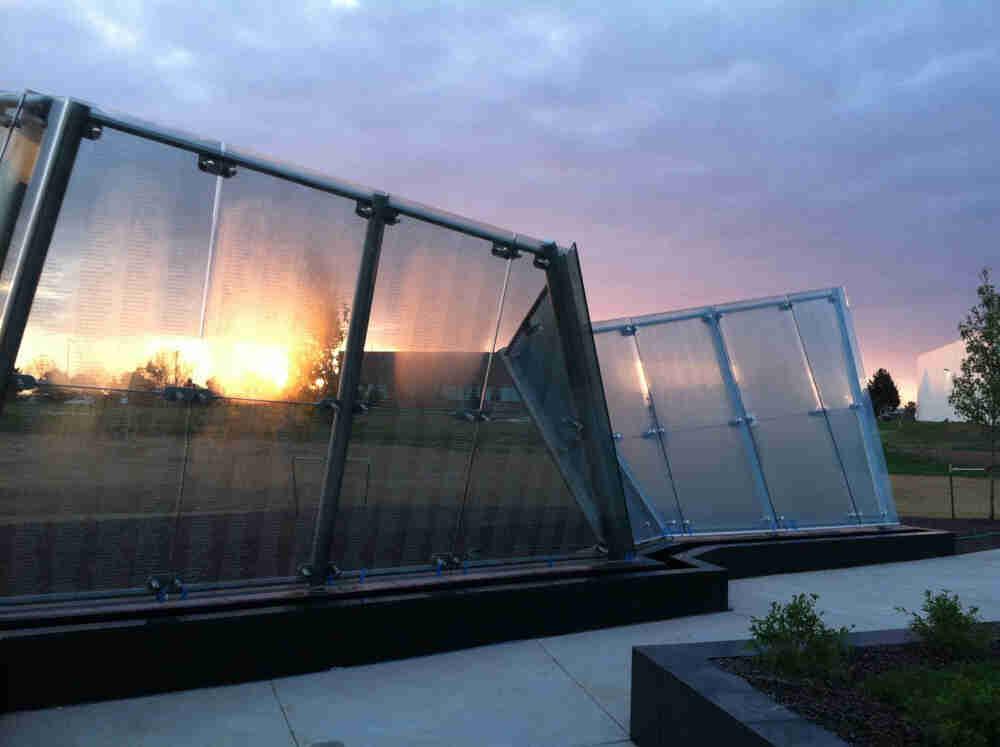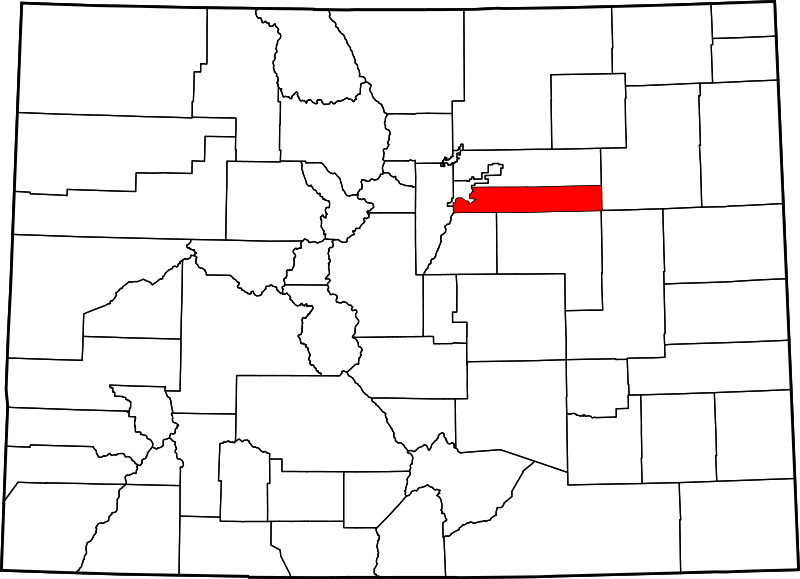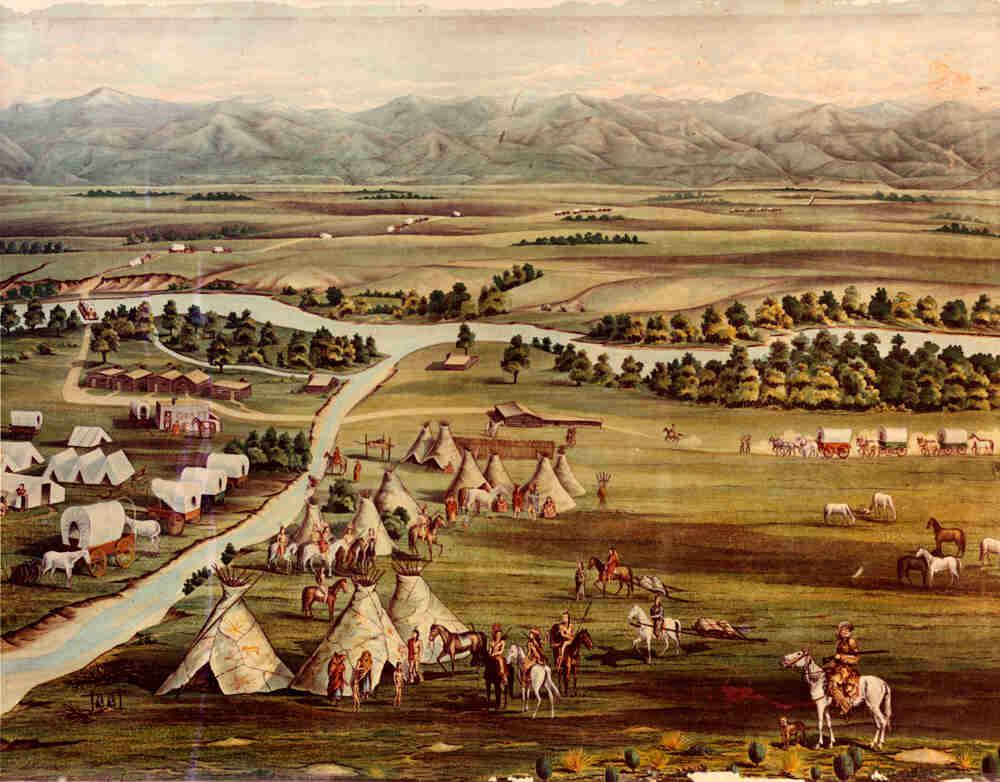Arapahoe County
Full Article
Arapahoe County covers 805 square miles in north central Colorado, running east across the high plains from the southern edge of Denver. It is named for the Arapaho, who once inhabited the area. One of the oldest counties in the state, Arapahoe County is bordered on the north by Denver and Adams Counties, on the west by Jefferson County, on the east by Washington County, and on the south by Douglas and Elbert Counties. With a population of more than 572,000, it is the third-most populous county in the state. Most of the county’s inhabitants live in the south Denver metro area, in the communities of Aurora, Englewood, and Littleton; the eastern part of the county consists mainly of farms, ranches, and smaller towns such as Byers and Bennett.
Arapahoe has the distinction of being Colorado’s first county, as it was created as part of the western limits of the Kansas Territory in 1855. The large, vertical rectangle that surveyors marked out in the middle of the plains certainly would have appeared strange to the Arapaho and Cheyenne, the two major Native American groups who followed the bison herds across the plains from the early nineteenth century. After Kansas was admitted to the union in 1861, Arapahoe County was resized and named one of the first seventeen counties in the new Colorado Territory. The original borders of the county stretched from the current western edge of Denver to the Kansas border. After gold was discovered along Dry Creek in 1858, a continuous flow of migrants from the east prompted the creation of new counties, and Arapahoe County was gradually pared down to its current size.
Indigenous Inhabitants
By the early nineteenth century, the area now known as Arapahoe County was the territory of the Cheyenne and Arapaho people. Both groups began as farmers in the upper Midwest, and gradually made their way west in the late eighteenth century. Territorial struggles with other groups, such as the dominant Lakota in the Black Hills, pushed them farther away from their original homelands, and the prospect of horses lured them onto the plains and into a life of nomadic hunting. The Cheyenne and Arapaho struck an alliance in 1811, and they chased bison herds and smaller game across the short-grass prairies of what are now the eastern stretches of Arapahoe County. Cottonwood stands along Cherry Creek and other tributaries of the South Platte River provided the Native Americans with food and shelter during the plains’ scorching summers and frigid, snowy winters.
By the 1820s, French fur trappers and traders were active in the region. The first trading post on the South Platte River was established in 1832 along Cherry Creek. Rumors of gold along the Front Range of the Rocky Mountains, circulated by trappers and mountain men, were common during this era, but no one paid much attention to them.
Discovery of Gold
In 1848 a group of prospectors on the way to California stopped to pan a few streams just west of present-day Denver. They found gold near present-day Englewood, where Dry Creek ran into the South Platte River. This was the first important discovery of gold in Colorado, but a bonanza was already going on further west and Colorado was not politically organized, so the find did not attract many people.
California-bound whites traveling through the area also feared attacks by Native Americans. In 1851 and 1853, the US government signed treaties with the Cheyenne and Arapaho, along with several other Plains groups, in which Native Americans agreed not to attack whites traveling along the overland routes. But white migration continued in the following years, and the Native Americans found their essential stands of cottonwoods depleted and huge swathes of their grazing grasses trampled by wagons or eaten by cattle. Many Cheyenne and Arapaho began to realize that the ceaseless flow of whites into their lands meant the complete destruction of their resource base; thus, the earlier treaties were broken and raiding resumed. Then, in 1857, Colonel Edwin V. Sumner of the US Army routed a group of Cheyenne in Kansas, and the small victory was enough to convince easterners that the westward routes were safe again.
The combination of Sumner’s victory and the Kansas-Nebraska Act of 1854, which created Arapahoe County within the Kansas Territory, now allowed so-called gold strikes to be investigated. By the summer of 1858, the Cherokee Party, headed by William Green Russell and named for the contingent of Indians he had brought with him from Georgia, had been panning the tributaries of the South Platte near present-day Denver for weeks. Many of the party, including frustrated Cherokees and impatient Georgian farmers who expected a quick strike, had given up and headed back east. Finally, on July 6, 1858, Russell and the remaining members of the party found gold along Dry Creek, just downstream from where traces had been panned out ten years earlier. News of the find quickly raced east, and others quickly assembled their own gold-digging parties. Several months later, on the east side of Cherry Creek, William Larimer, Jr. founded Denver City, the first seat of Arapahoe County.
Removal of Indigenous People
Farmers and ranchers soon followed the prospectors into what is now the southwest corner of Arapahoe County. Their houses, fences, and crops took wood and water from the all-important groves along the tributaries, and their herds ate up acres of the Cheyenne and Arapaho’s best grazing lands. In 1861 a reservation was established in southeastern Colorado for the Cheyenne and Arapaho, but by this time the Indian bands were split between those who favored cooperating with the whites and those who favored resisting them.
Both paths led to the end of the nomads’ life on the plains as they knew it: the government rarely had the ability or the desire to take care of peaceful Indigenous groups, and warrior bands had to deal not only with the larger and better-equipped US military, but also with dwindling plains resources due to growing white settlements.
The unprovoked massacre of more than 150 peaceful Arapaho and Cheyenne—mostly women, children, and the elderly—at Sand Creek in 1864 prompted more than a decade of warfare between the US military and resulted in an alliance of Arapaho, Cheyenne, Lakota, and other Plains Indians. In 1867, the Medicine Lodge Treaty established the Cheyenne-Arapaho Reservation in central Oklahoma, then known as “Indian Territory.” Though sporadic raiding by the Arapaho and their allies continued into the 1870s, by the end of the nineteenth century Arapahoe County was mostly cleared of the people it was named for.
Early Towns
After the Colorado Gold Rush, farming and ranching were the backbone of eastern Arapahoe County, while towns continued to develop around Denver. Englewood, established in 1864 by the Irish homesteader Thomas Skerritt, was connected to Denver via roads by the 1880s and featured a notorious skid row in an area known as Orchard Place. Meanwhile, G. A. Snow, a cattle rancher from New York, owned some 12,000 acres—almost half his ranch—in the eastern part of the county. The Snow family maintained the ranch from 1871 until 1957. Other large ranches included Parrett Ranch, Owens Ranch, and Price Ranch.
The town of Bijou was founded in 1870, and in 1889 the name was changed to Byers, in honor of Rocky Mountain News founder William Byers. In 1872, Richard Little, an engineer from New Hampshire who had come to Denver to map out irrigation ditches during the gold rush, obtained a permit to develop his land into the village of Littleton. The arrival of the Denver & Rio Grande Railroad in 1871 brought more residents to the town, and in 1890 Littleton was incorporated with a population of 245. Englewood incorporated in 1903.
In 1902 the state legislature divided the old Arapahoe County into the current counties of Arapahoe, Adams, Denver, Washington, and Yuma. Littleton was at first deemed the temporary county seat; an election in 1904 secured it as the permanent seat of the new Arapahoe County.
Like many other rural areas on the outskirts of major US cities, Arapahoe County experienced rapid growth after World War II, when housing developments sprang up and led to the suburbanization of the county. As both Littleton and Aurora began annexing more and more of these developments, communities in the western portion of the county faced many challenges associated with rapid growth, including effective urban planning and the provision of municipal services. As their communities grew, residents of Arapahoe County were also aware that they would likely have to decide whether they should link up with the city—then facing its own postwar dilemmas of a shrinking tax base and urban decay—or remain independent.
Disputes with Denver
After World War II, the suburban communities of Littleton and Aurora found themselves at odds with the state capital over multiple issues, particularly water rights and land annexation. At the beginning of a seven-year drought in 1950, Denver sought to protect its water supply by prohibiting new hookups beyond a boundary drawn by members of the Denver Water Board. Both Littleton and Aurora were beyond this boundary and had to come up with their own water supplies.
Aurora pieced together its supply by purchasing rights to irrigation water from ranches on the South Platte River. Although the Littleton City Council purchased additional tanks in 1949 and 1951, in 1953 it still lacked enough water to adequately provide for residents. Littleton eventually entered into a tri-city agreement with Denver and Englewood to purchase and share additional water. The city reentered Denver Water’s service area in 1970 and continues to receive Denver water today. Aurora, meanwhile, continued to secure additional water on its own into the 1990s. In 1967 it brokered a $50 million agreement with Colorado Springs to share water from the Homestake Project, which diverted Homestake Creek—a tributary of the Eagle River—into Spinney Mountain Reservoir.
Sources of tension between city and suburb were not limited to the drought crisis during the 1950s. In 1955, Arapahoe County residents in the subdivision adjacent to the University Hills Shopping Center petitioned for annexation to Denver, but county officials sought to retain the shopping center area for its important tax revenue. Arapahoe County won the first round of litigation but was ultimately unable to keep Denver from annexing the property.
Annexation was another major source of tension between Denver and its suburbs during the 1960s and 1970s. During the 1960s, Republican legislators from Arapahoe County were part of the core opposition to multiple efforts to create an “Urban County” that would have assimilated Littleton and Aurora into Denver. In 1972 Arapahoe County sued Denver, arguing that it should provide water to its residents even though they did not live within city limits. Although the suit had poor legal foundation and was settled out of court, it did prompt Denver to drop its condition that areas wishing to be served by Denver Water be annexed first. In 1973 Aurora countered Denver’s annexation campaign with its own, seizing some 4,000 acres (although it targeted many more) and securing the coveted Cherry Hills School District. The series of annexation disputes between Arapahoe and Denver Counties was finally put to an end in 1974, when the Poundstone Amendment to the state constitution froze Denver’s boundaries.
Aurora
The town of Fletcher was incorporated in 1891 and received its current name of Aurora in 1902. The city, now supporting a population of more than 335,000, has a rich military heritage. Army General Hospital No. 21 was built on Aurora’s east side in 1918, and Lowry Air Force Base was established just southwest of the city in 1938. The general hospital, renamed Fitzsimons Army Hospital, was expanded in 1941 and treated soldiers injured during World War II. Aurora is also home to the Colorado Freedom Memorial, completed in 2013 and dedicated to all of Colorado’s deceased military veterans.
Over the past few decades, Aurora has become one of Colorado’s most diverse cities, making it a destination for immigrants and refugees from around the globe. In 1990 Latinos made up just 7 percent of the city’s population, but today they account for nearly a third of its 353,000 residents. African Americans make up 4 percent of the state population but nearly 16 percent of Aurora residents, and Asians account for almost 5 percent of the city’s population as opposed to just 2.8 percent of Coloradans.
The city’s diversity and economic opportunities have also made it attractive for immigrants and refugees. People from Bhutan and Ethiopia began arriving in larger numbers in the mid-2000s, and an estimated 4,000 refugees from Sudan and other nations arrived between 2012 and 2013. As of 2013, 21 percent of Aurorans were born in another country—the highest percentage in the Denver metro area. In response, the city opened the Immigrant Welcome Center in 2014 to help newcomers learn English, become citizens, and find employment and legal counsel.
In 2012 the city became nationally known because of the horrific Aurora theater shooting. On July 20, twenty-four-year-old James Holmes entered a midnight screening of The Dark Knight Rises at the Century Aurora 16 theater and opened fire on the audience with an AR-15 assault rifle, killing twelve and wounding fifty-eight. Police found that Holmes had been stockpiling weapons and ammunition for months, and he also apparently expected his apartment to be searched, leaving it rigged with booby traps. He obtained all his weapons and ammunition legally. The tragedy sent emotional shockwaves across the nation, and renewed a previously dormant conversation about gun control in the midst of a bitterly polarized presidential election season.
Today
The western quarter of Arapahoe County is currently home to the expanding Denver metro area, with many subdivisions, parks, and businesses. Office complexes such as the Denver Technology Center and Greenwood Plaza house many local and international corporations. Farms and ranches occupy the rest of the county. Between 2007 and 2012, the county added 128 farms, and in 2012 Arapahoe was ranked in the top third of wheat-producing counties in the state.
























